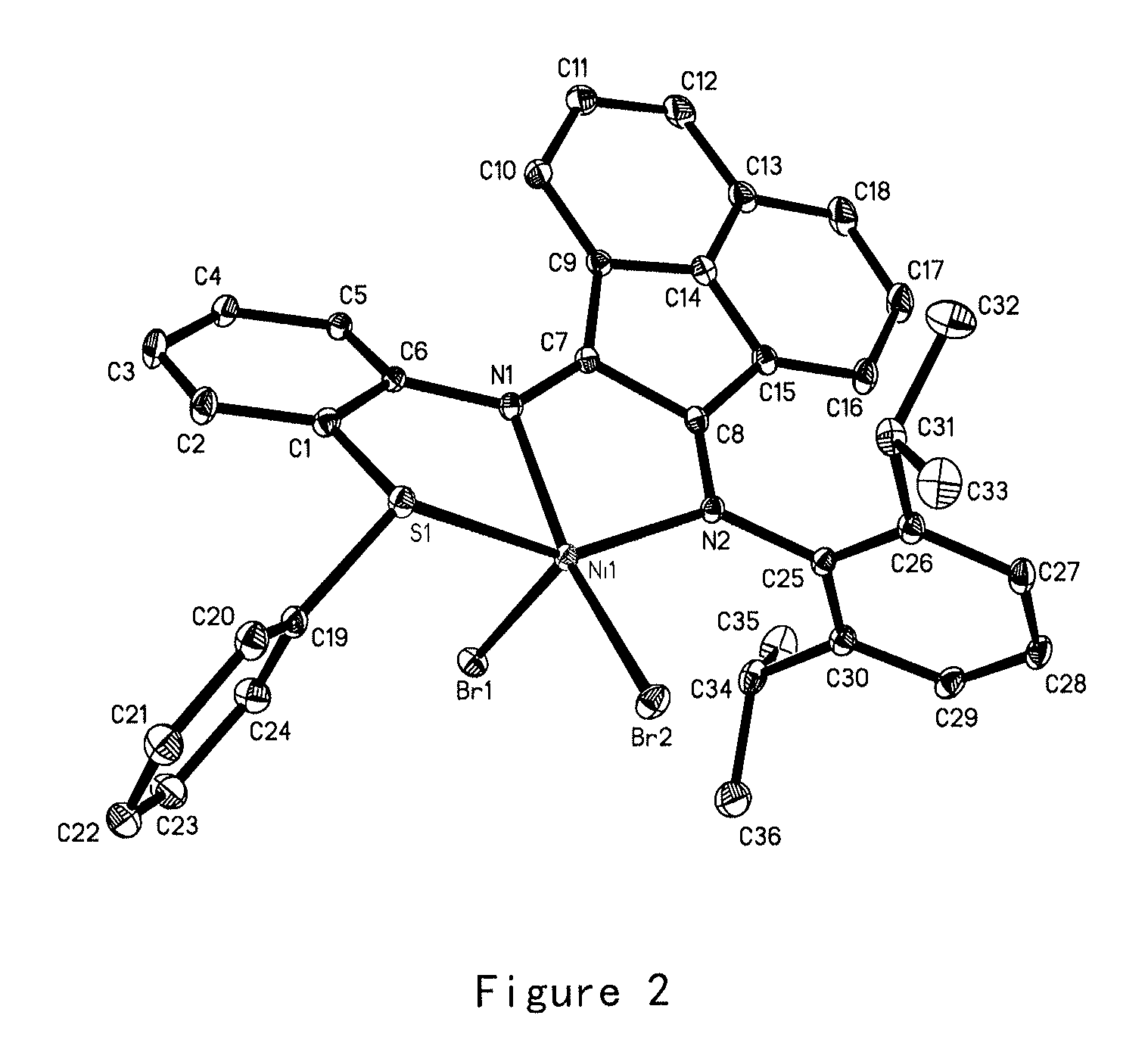Catalytic system for preparation of high branched alkane from olefins
a technology of branched alkane and catalytic system, which is applied in the field of catalytic system, can solve the problems of severe -h elimination, low activity of this system, and no significant progress in this area
- Summary
- Abstract
- Description
- Claims
- Application Information
AI Technical Summary
Benefits of technology
Problems solved by technology
Method used
Image
Examples
example 1
Synthesis of Ligand L1a
[0214]
[0215]In 100 mL egg-shaped flask, acenaphthoquinone (3.644 g, 20 mmol), methanol (40 ml), 2,6-diisopropyl aniline (4.0 mL, 20 mmol), two drops of acetic acid were added and the mixture was stirred at room temperature. The reaction was monitored by TLC until ended. The reaction mixture was concentrated under reduced pressure, and purified by column chromatography on alumina N-neutral using EA:PE from 1:20 to 1:10 to give the single imine as orange yellow product (yield 60%). 1H NMR (300 MHz, CDCl3): δ=8.21 (2H, m), 8.01 (1H, d), 7.82 (1H, t), 7.41 (1H, t), 7.27 (3H, s), 6.64 (1H, d), 2.84 (2H, m), 1.18 (6H, d), 0.90 (6H, d).
[0216]In 100 mL egg-shaped flask, the single imine (1.708 g, 5.0 mmol), methanol (40 ml), aniline (7.5 mmol) and two drops of anhydrous acetic acid were added. The reaction mixture was stirred at room temperature. The reaction was monitored by TLC until ended. The reaction mixture was concentrated under reduced pressure, and purified b...
example 2
Synthesis of Ligand L1b
[0217]
[0218]Following the synthesis of ligand L1a of example 1, an orange solid was obtained under the identical operating conditions except that aniline was replaced by 2,6-dichloro aniline in the second step. 1H NMR (300 MHz, CDCl3): δ=8.32 (1H, d), 8.10 (1H, d), 7.96 (1.5H, m), 7.53 (2H, d), 7.41 (3H, m), 7.38 (2H, m), 6.91 (0.5H, m), 6.58 (1H, t), 2.77 (2H, m), 1.29 (2H, d), 0.97 (10H, d), 13C NMR (75 MHz, CDCl3): δ=162.2, 157.8, 146.1, 133.1, 130.7, 127.5, 124.8, 124.4, 124.3, 123.39, 123.1, 122.7, 120.7, 77.4, 77.6, 28.5, 27.9, 23.5, 22.8. IR(KBr): v(cm−1)=3052, 2960, 2923, 2865, 1674, 1640, 1602, 1463, 1433, 1242, 1077, 1033, 831, 779, 760, 730; C30H26Cl2N2 (484.45): Anal. Calc. C, 74.22; H, 5.40; N, 5.77. Found C, 73.99; H, 5.39; N, 5.65.
example 3
Synthesis of Ligand L1c
[0219]
[0220]Following the synthesis of ligand L1a in example 1, an orange red solid was obtained under the identical operating conditions except that aniline was replaced by 2,6-dibromoaniline in the second step. 1H NMR (300 MHz, CDCl3): δ=8.33 (1H, d), 8.05 (1H, d), 7.91 (2H, m), 7.69 (1.5H, d), 7.49 (2H, d), 7.28 (1H, m), 7.15 (2H, s), 6.71 (1H, m), 6.69 (1H, t), 6.51 (0.5H, d), 1.23 (2H, d), 0.97 (10H, d); 13C NMR (75 MHz, CDCl3): δ=162.2, 157.5, 149.1, 146.2, 141.2, 135.3, 134.7, 131.3, 128.9, 124.4, 120.8, 112.1, 77.0, 58.4, 28.0, 23.8, 23.1, 23.0, 18.4. IR(KBr): v(cm−1)=3058, 2960, 2922, 2865, 1677, 1640, 1594, 1547, 1462, 1425, 1282, 1241, 1080, 1032, 925, 831, 792, 778, 759, 725; C30H26Br2N2 (574.35): Anal. Calc. C, 62.74; H, 4.56; N, 4.88. Found C, 62.69; H, 4.60; N, 4.73.
PUM
| Property | Measurement | Unit |
|---|---|---|
| bromine number | aaaaa | aaaaa |
| viscosity index | aaaaa | aaaaa |
| viscosity index | aaaaa | aaaaa |
Abstract
Description
Claims
Application Information
 Login to View More
Login to View More - R&D
- Intellectual Property
- Life Sciences
- Materials
- Tech Scout
- Unparalleled Data Quality
- Higher Quality Content
- 60% Fewer Hallucinations
Browse by: Latest US Patents, China's latest patents, Technical Efficacy Thesaurus, Application Domain, Technology Topic, Popular Technical Reports.
© 2025 PatSnap. All rights reserved.Legal|Privacy policy|Modern Slavery Act Transparency Statement|Sitemap|About US| Contact US: help@patsnap.com



